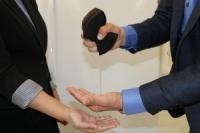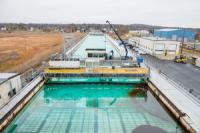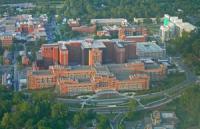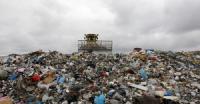-
Super sponge effectively removes toxins from lakes

Mercury is very toxic and can cause long-term health damage, but removing it from water is challenging. To address this growing problem. Researchers have created a sponge that can absorb mercury from a polluted water source within seconds. The sponge converts the contamination into a non-toxic complex so it can be disposed of in a landfill after use. The sponge also kills bacterial and fungal microbes.
-
-
Reusable sponge soaks up oil, revolutionizes oil spill, diesel cleanup

When the Deepwater Horizon drilling pipe blew out seven years ago, beginning the worst oil spill in U.S. history, those in charge of the recovery discovered a new wrinkle: the millions of gallons of oil bubbling from the sea floor weren’t all collecting on the surface where it could be skimmed or burned. Some of it was forming a plume and drifting through the ocean under the surface. Now, scientists have invented a new foam, called Oleo Sponge, that addresses this problem. The material not only easily absorbs oil from water, but is also reusable and can pull dispersed oil from the entire water column—not just the surface.
-
-
Future CO2 levels, climate warming unprecedented in 420 million years
New research suggests that, over the next 100 to 200 years, carbon dioxide concentrations in the Earth’s atmosphere will head towards values not seen since the Triassic period, 200 million years ago. Furthermore, by the twenty-third century, the climate could reach a warmth not seen in 420 million years.
-
-
Selecting to right first responder technology
With the abundance of tools and technologies available to assist first responders, it is important to address questions such as: How do the tools perform in real-world response situations? Can they withstand uncertain environments? Are they easy to use when a responder is wearing protective gear? How heavy is the technology? Will it weigh down, or fit within the gear of a responder who is already wearing their full kit? To help first responders answer these questions so they can make informed decisions about technology acquisition, DHS Science and Technology Directorate (S&T) First Responders Group (FRG) hosted a 3-day Urban Operational Experimentation (OpEx).
-
-
Monitoring critical minerals to ensure national preparedness
In 2014, the Defense Logistics Agency (DLA) came to a startling conclusion: The United States needed to increase its stockpile of a basic manufacturing material with military applications — yttrium oxide, a material used in laser rangefinders. This shortfall meant that in 2014, the DLA had to submit a request to Congress to acquire new material for the National Defense Stockpile. The DLA has a watch list of about 160 materials, and economists at the agency have developed an early warning system that let them concentrate on high-priority materials.
-
-
Study: NIH funding generates large numbers of private-sector patents

Research grants issued by the National Institutes of Health (NIH) contribute to a significant number of private-sector patents in biomedicine, according to a new study. The study, published in the journal Science, examines twenty-seven years of data and finds that 31 percent of NIH grants, which are publicly funded, produce articles that are later cited by patents in the biomedical sector. “The impact on the private sector is a lot more important in magnitude than what we might have thought before,” says one of the researchers.
-
-
Bringing values, not just facts, to climate fight
The facts, unfortunately, don’t speak for themselves. That’s why scientists have to speak out, according to Naomi Oreskes, a Harvard history of science professor who has taken a close look at the causes and effects of climate change denial. Denial, she said, isn’t about science but about individualism, skepticism of government power, the self-interest of those in affected industries, and conceptions of freedom. For those moved by those concerns, climate change is just the latest in a series of scientific problems leading to greater government intrusion. Disputing climate facts has roots in fear, Oreskes said — not of climate, but of higher taxes, bigger government, and lost freedoms.
-
-
Managed retreat: Relocating communities to get them out of harm’s way
More frequent extreme weather events put certain regions in the cross hairs of risks such as coastal flooding, heavy rain, and erosion. There is an obvious, but controversial, solution: relocating communities from vulnerable to safer areas. Based on examples from around the world, researchers chart the landscape for whether and how to implement the strategy of managed retreat – and how, with the minimum disruption possible, relocate or abandon development in the face of extreme weather risks.
-
-
Sea level rise makes much of Honolulu and Waikiki groundwater vulnerable to inundation
Researchers found that a large part of the heavily urbanized area of Honolulu and Waikīkī is at risk of groundwater inundation — flooding that occurs as groundwater is lifted above the ground surface due to sea level rise. “Our findings suggest that coastal communities in Hawai’i and globally are exposed to complex groundwater flooding hazards associated with sea level rise in addition to the typical concerns of coastal erosion and wave overtopping,” said one researchers. “Groundwater inundation will require entirely unique adaptation methods if we are to continue to live in and develop the coastal zone. Coastal planners and community stakeholders will need to work with architects, engineers, geologists, ecologists, economists, hydrologists and other innovative thinkers in order to manage these problems.”
-
-
Aging U.S. scientific workforce raises concerns
The science and engineering workforce in the United States is aging rapidly, according to a new study. And it is only going to get older in coming years. Economists found that the average age of employed scientists increased from 45.1 to 48.6 between 1993 and 2010, faster than the workforce as a whole. The study estimates that, all else being the same, the average age of U.S. scientists will increase by another 2.3 years in the near future.
-
-
Under climate change, farming is becoming riskier
Climate change will have an impact on agriculture, but a new study puts these changes in terms which are directly applicable to farmers. For Illinois, for example, the corn planting window will be split in two to avoid wet conditions in April and May. Each planting window carries increased risk – the early planting window could be thwarted by frost or heavy precipitation, and the late window cut short by intense late-summer drought. Farmers and crop insurers must evaluate risk to avoid losing profits.
-
-
MIT president calls for investing in basic science to maintain U.S. edge
President Trump’s proposed budget slashes at least $7 billion in funding for science programs. That course of action would put the United States at a competitive disadvantage, argues L. Rafael Reif, president of the Massachusetts Institute of Technology (MIT). “Since World War II, the U.S. government has been the world’s biggest supporter of potentially transformative science — which is a key reason why the country continues to have the highest share of knowledge- and technology-intensive industries in the world, amounting to nearly 40 percent of the economy,” Reif writes in the May/June issue of Foreign Affairs.
-
-
NSF-funded research continues to support national security
The National Science Foundation (NSF) is usually associated with supporting scientists who go on to win Nobel Prizes, leading exploration of the planet’s polar regions, and enabling discoveries about the universe, from the subatomic world to distant galaxies. But the foundation also has ties to national defense that go back to its beginnings, as a product of the U.S. government working to enhance security during and after the Second World War. The National Science Foundation Act of 1950 called for the creation of an agency to “promote the progress of science; to advance the national health, prosperity, and welfare; and to secure the national defense.” NSF’s founder, Vannevar Bush, said: “It has become clear beyond all doubt that scientific research is absolutely essential to national security.”
-
-
Carbon Law, modeled after Moore’s Law, a pathway to halve emissions every decade

Moore’s Law states that computer processors double in power about every two years. While it is neither a natural nor legal law, this simple rule of thumb or heuristic has been described as a golden rule which has held for fifty years and still drives disruptive innovation. Research say that a carbon roadmap, driven by a simple rule of thumb, or Carbon Law, of halving emissions every decade, could catalyze disruptive innovation. Following a Carbon Law, which is based on published energy scenarios, would give the world a 75 percent chance of keeping Earth below 2°C above pre-industrial temperatures, the target agreed by nations in Paris in 2015.
-
-
Have humans transformed geological processes to create a new epoch -- the Anthropocene?

The Anthropocene — the concept that humans have so transformed geological processes at the Earth’s surface that we are living in a new epoch — was formulated by Nobel Laureate Paul Crutzen in 2000. It has since spread around not just the world of science, but also across the humanities and through the media into public consciousness. An international group of scientists – the Anthropocene Working Group – is now analyzing the Anthropocene as a potential new addition to the Geological Time Scale, which would be a major step in its global scientific recognition. These scientists argue that “irreversible” changes to the Earth provide striking evidence of new epoch.
-
More headlines
The long view
New Technology is Keeping the Skies Safe
DHS S&T Baggage, Cargo, and People Screening (BCP) Program develops state-of-the-art screening solutions to help secure airspace, communities, and borders
Factories First: Winning the Drone War Before It Starts
Wars are won by factories before they are won on the battlefield,Martin C. Feldmann writes, noting that the United States lacks the manufacturing depth for the coming drone age. Rectifying this situation “will take far more than procurement tweaks,” Feldmann writes. “It demands a national-level, wartime-scale industrial mobilization.”
How Artificial General Intelligence Could Affect the Rise and Fall of Nations
By Barry Pavel et al.
Visions for potential AGI futures: A new report from RAND aims to stimulate thinking among policymakers about possible impacts of the development of artificial general intelligence (AGI) on geopolitics and the world order.
Smaller Nuclear Reactors Spark Renewed Interest in a Once-Shunned Energy Source
By David Montgomery
In the past two years, half the states have taken action to promote nuclear power, from creating nuclear task forces to integrating nuclear into long-term energy plans.
Keeping the Lights on with Nuclear Waste: Radiochemistry Transforms Nuclear Waste into Strategic Materials
By John Domol
How UNLV radiochemistry is pioneering the future of energy in the Southwest by salvaging strategic materials from nuclear dumps –and making it safe.
Model Predicts Long-Term Effects of Nuclear Waste on Underground Disposal Systems
By Zach Winn
The simulations matched results from an underground lab experiment in Switzerland, suggesting modeling could be used to validate the safety of nuclear disposal sites.
